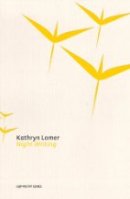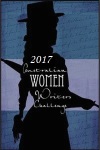Kathryn Lomer, Night Writing (University of Queensland Press 2014)
 Kathryn Lomer has been to places I’ve been, loved music I’ve loved, had experiences similar to mine, learned things I’ve learned, and uses words about them that opens doors for me. A rural Catholic childhood, science and maths, bushwalking, parenthood, sex, the ups and downs of relationships, camping holidays, birds, cattle, several kinds of loss, several kinds of revival, surgery, music, visual art and sculpture, the quality of daylight, Brisbane and Melbourne art galleries, North Queensland tourist spots: she makes warm, intelligent, accessible poetry from all these.
Kathryn Lomer has been to places I’ve been, loved music I’ve loved, had experiences similar to mine, learned things I’ve learned, and uses words about them that opens doors for me. A rural Catholic childhood, science and maths, bushwalking, parenthood, sex, the ups and downs of relationships, camping holidays, birds, cattle, several kinds of loss, several kinds of revival, surgery, music, visual art and sculpture, the quality of daylight, Brisbane and Melbourne art galleries, North Queensland tourist spots: she makes warm, intelligent, accessible poetry from all these.
An attractive feature of her work is the way it’s grounded in science and physical experience, while open to kinds of feeling generally associated with religion or fantasy. This stanza from ‘Measure’, for example:
I used to make shell necklaces on Hawley Beach,
my mother saying fairies made the shell holes
to help little children do just that.
I tell my son sea urchins
drill a hole to get at food inside.
Truth is also extraordinary
And how about this bit of taxonomical music from ‘Spyhopping’, which is addressed to humpback whales:
Your name is a parsing of the past:
animalia chordata vertebrata mammalia
cetacea mysticeti balaenopteridae
megaptera novaeangliae;
a prayer said in Latin
that you survive.
The book is in five sections. There’s a lot to say about all of them, but I’ll start with the fourth, ‘Eclipse plumage’, which reads pretty much as a narrative. The title poem gives the set-up:
I read in my bird book of females’
changed feathers after breeding:
eclipse plumage.
They become undistinguished.
Here, my colour has come back.
It’s all the walking, I say.
The fresh air. The land.
Silly, I know, but I grin
all the way to the river.
In the next poem, ‘Paddock bull’, the bull is not distracted by cows lowing in the next paddock, ‘though I detect a little bit of pink interest’. And from there on, a narrative can be pieced together: ‘Here’ in the lines above is an artists’ and writers’ retreat at Bundanon in New South Wales, and the returning colour is the stirrings of desire, in abeyance since she became a mother, presumably some years before; a painter of birds reciprocates, they vacillate (‘we’ve said the timing isn’t right, / but all day we will wonder / What if it is?‘), go for it (as conveyed in ‘Lovers below Brasso tin’ which mainly describes the drypoint by Arthur Boyd for which it is named, in which ‘lovers are suspended in lust’), and in a final two poems ‘Men without sorrows’ and ‘Contentment’ say goodbye.
Nine of the ten poems in the section contribute at least indirectly to this narrative – which raises questions about the other poem, a double sestina at the beginning of the section, ‘The fencer and his mate’. (A sestina has six 6-line stanzas, each stanza having the same six end-words, but in a changing order, followed by a 3-line stanza using all six ‘end-words’. ‘The fencer and his mate’ does it twice, with two sets of end-words.) It’s a stunning poem in its own right. As if the complex recurrent rhymes aren’t enough, a number of other words and motifs recur, and the poem’s technical whizzery functions as a kind of homage to the fencers’ skill with their axes and saws. Nothing in it relates obviously to the main narrative of the section, but then near the end of ‘Contentment’, there’s this:
Across the Shoalhaven, a dead tree is chain-sawed for firewood,
next winter’s warmth to be storedas comforting in its woodpile pattern
as the promise of love
That stands by itself, but it also sends us back to the final lines of that first poem, which on first reading struck an odd note by speaking of ‘love’ between the fencer and his mate (rhyme words are straight, earn, axe, true, sleep and new):
and moist and ready. To tell it straight, what they can earn
is each other’s love, that feeling like an axe, something fine and true,
like a sound sleep, two lives made new.
We’re left with the hovering notion of ‘two lives made new’ in a passing holiday affair.
Once I’ve committed myself to reading for narrative, it’s hard not to read the final section, ‘Holy Days’, as telling what happens next. There’s a rough equivalent to the earlier poem’s new plumage in ‘Shy’, which speaks of the ‘platypus of the bedroom’:
it comes in only at night,
wraps itself around my waist and thighs,
strokes my breast and buttocks,
nuzzles, sometimes settles on my belly.
Gone is the begetting,
the wearing, the faring well.
Here in the dark,
all is fine.
There’s a man who spends time with the poet and the son who was noticeably absent from the ‘Eclipse Plumage’ section. This man seems to be a keeper, and when the two of them go on a North Queensland holiday in the sequence ‘Holy Days’ (roughly a quarter of the section) there’s no need for a Boyd print to convey their physical joy in each other. Then in a couple of lines that must bring joy to the heart of anyone raised as a Catholic:
Yes, it’s an indulgence.
As a child, and in my church,
the word meant punishment was cancelled,
everything forgiven.
They’ve skipped purgatory
and sent me straight to heaven.
 Night Writing is the second book I’ve read for the 2017 Australian Women Writers Challenge.
Night Writing is the second book I’ve read for the 2017 Australian Women Writers Challenge.


Jonathan: there seems to be nothing to which you cannot bring your warm generous gaze! There is genuine joy and delight in the way you examine the words and the experiences of Kathryn LOMER’s equally beautiful reflective writing. I am reading Stefan HERTMAN’s War and Turpentine (translated by David McKAY so perfectly – so it seems to me – that I believe I am reading Stefan without translation – another examination of a soldier who survived – somehow – The Great War – and who many years later wrote diaries of that experience – the author remembering his grand-father and using the grand-father’s love for his own painter father – much “used” by the church who dies in his latter 30s of consumption – to turn this work into something some have already compared to Remarque. There is tenderness and grief in equal measure – and I am a mere 40% into it – and we are not quite yet into the trenches!) Kathryn’s writing clearly does not have that intent – but the way you have written of her evokes something in me which sees that same quality of tenderness.
LikeLike
Happy New Year, Jim. I’ve just added War and Turpentine to my list of books to read. Tenderness is definitely there in Kathryn Lomer’s work
LikeLike